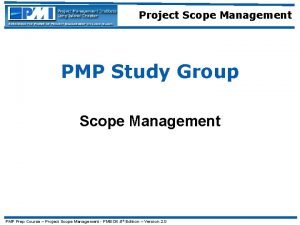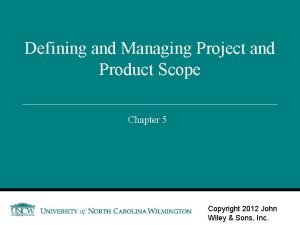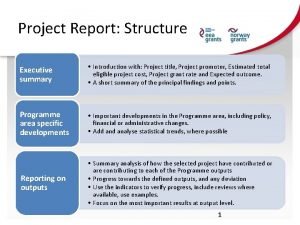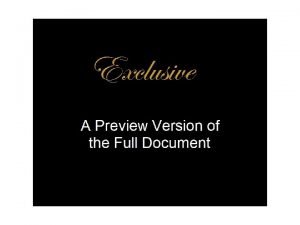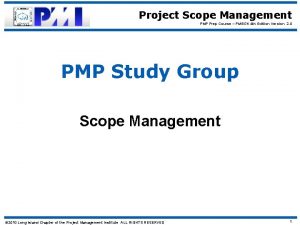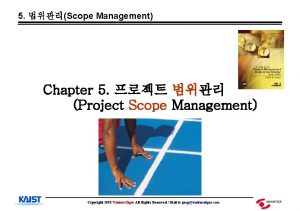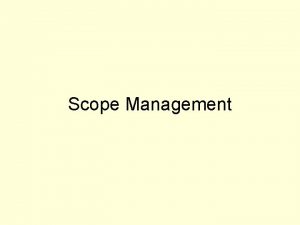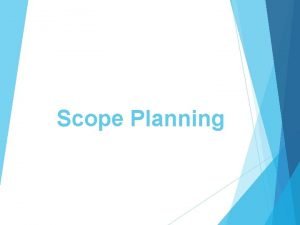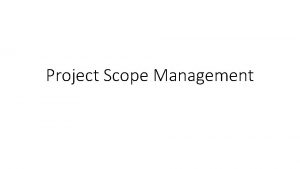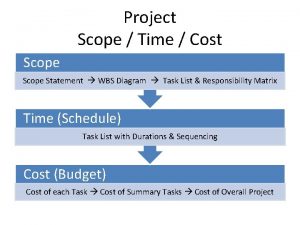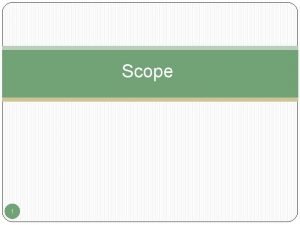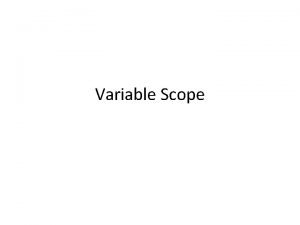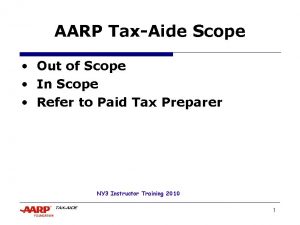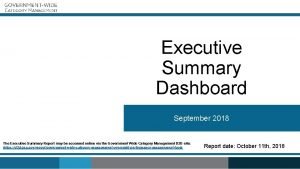PROJECT NAME Scope Statement CONTENT Executive Summary Project











- Slides: 11

<PROJECT NAME> Scope Statement

CONTENT. . Executive Summary Project Rationale, Goals, and Objectives Major Benefits Key Requirements Key Deliverables Items Out of Scope Assumptions, Constraints, and Dependencies Project Approach Critical Success Factors ©. CPC Seite 2

EXECUTIVE SUMMARY [Purpose of this section: Provide a brief description of the scope of the project. Explain what the current business problem is or the business needs which can also be included from the Charter. Identify any significant deliverables or milestones and the estimated timeframe expected for completion. Although it seems to be duplicate effort to cut-andpaste (and summarize as required) these two sections, it eliminates the need for the reader to flip to a separate document to get the quick project perspective that is required here. ] [If items covered in the various sections in the Charter have evolved since Charter signoff, insert the appropriate section topic and restate the latest information here. The Charter should not change after it is approved. Any changes after signoff of the Charter will be captured in the Project Plan. ] ©. CPC Seite 3

PROJECT RATIONALE, GOALS, AND OBJECTIVES [Purpose of this section: Provide a rationale for which the project is undertaken. Clearly explain the goals and objectives in a manner that is measurable upon completion of the project. For example: One goal may be to develop a new web application for dealers to provide potential customers a car or truck brochure within 2 business days upon request. ] ©. CPC Seite 4

MAJOR BENEFITS [Purpose of this section: Cite any known or potential cost savings, reduction in effort, time savings, etc. , as a result of completing the project. For example: A major benefit as a result of the project may be to take advantage of the changes in currency rates between North America and Europe. ] ©. CPC Seite 5

KEY REQUIREMENTS [Purpose of this section: Document the high level business (key) requirements of the project. The key requirements should be uniquely identified, have a clear description, be measurable, traceable, have a source, and defined acceptance criteria. For example: A key requirement may be that the application be multi currency. ] ©. CPC Seite 6

KEY DELIVERABLES [Purpose of this section: Document the high level (key) deliverables of the project. The key deliverables could be project management (PM) and technical in nature. For example: Key PM deliverables include a Business Case, Project Charter, Project Plan, and Project Schedule. An example of key technical deliverables could include the IT application, user manuals, and training materials. ] ©. CPC Seite 7

ITEMS OUT OF SCOPE [Purpose of this section: Document specific elements of the project that are out of scope. For example: Special cars like the Mercedes-Benz SLR may be out of scope for mailing brochures with 2 business days upon request. Another example is an application that may be specific to North America and out of scope for Europe and Asia. ] ©. CPC Seite 8

ASSUMPTIONS, CONSTRAINTS, AND DEPENDENCIES [Purpose of this section: Cite any known constraints (resources, budget, time, desired start and end dates, infrastructure, etc. ) and assumptions about the project or the solution. Indicate any dependencies on existing, in-process, or planned work. For example: A predefined budget is a constraint that will limit the project scope, resources, and schedule. An assumption could be that the human resources are assigned for the duration of the project. A dependency is an event that will cause the project to be cancelled or late if the event does not occur as planned. ] ©. CPC Seite 9

PROJECT APPROACH [Purpose of this section: Document the project’s “strategy” to successfully achieve the project goals. The approach for a specific project is determined by the specific project goals, the characteristics key requirements and key deliverables. This also includes the underlying general assumptions and constraints. For example: An approach may be to buy a Commercial Off The Shelf (COTS) application instead of developing an in house solution or do a combination of both. ©. CPC Seite 10

CRITICAL SUCCESS FACTORS [Purpose of this section: Key areas of activity in which favourable results are necessary for a project to reach its goal. Cite the project’s Critical Successful Factors (CSF). The project’s CSF includes factors like continued management support or continued funding for the project. CSF can also be directly measured. For example: An increase in the number of hits on a web site or an increase in user satisfaction measured by a decrease in help desk calls. ] ©. CPC Seite 11
 Product scope vs project scope
Product scope vs project scope Io2br3
Io2br3 Executive summary for solar project
Executive summary for solar project Executive summary of project report
Executive summary of project report Executive summary of project charter
Executive summary of project charter Executive summary for e commerce project
Executive summary for e commerce project Project charter and scope statement
Project charter and scope statement Example of project scope statement
Example of project scope statement Wbs dictionary example
Wbs dictionary example Carrier content vs real content
Carrier content vs real content Static content vs dynamic content
Static content vs dynamic content Name three lines
Name three lines
